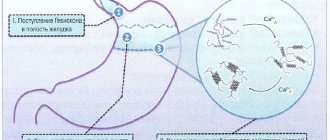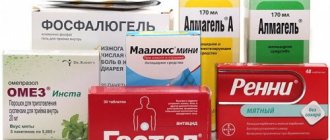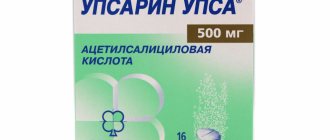Compound
| Oral suspension | 10 ml |
| active substances: | |
| sodium alginate | 1000 mg |
| potassium bicarbonate | 200 mg |
| Excipients | |
| oral suspension (anise): calcium carbonate - 200 mg; carbomer - 40 mg; methyl parahydroxybenzoate - 40 mg; propyl parahydroxybenzoate - 6 mg; sodium hydroxide - 14.44 mg; sodium saccharinate - 10 mg; fennel flavor - 7 mg; purified water - up to 10 ml | |
| oral suspension (mint): calcium carbonate - 200 mg; carbomer - 40 mg; methyl parahydroxybenzoate - 40 mg; propyl parahydroxybenzoate - 6 mg; sodium hydrogen oxide - 14.44 mg; sodium saccharinate - 10 mg; mint flavor - 6 mg; purified water - up to 10 ml |
Composition of Gaviscon
Gaviscon contains 3 substances.
This medicine is available in the form of chewable tablets and suspension under the trade name:
- "Gaviscon mint"
- "Gaviscon Forte mint"
- Gaviscon Double Action.
It is packaged in bottles of various sizes or in bags. The tablets are packaged in blisters; they are placed in packages with different contents from 8 to 32 pieces. Composition of the drug:
special instructions
In 10 ml of suspension the sodium content is 106 mg (4.6 mmol) and potassium 78 mg (2 mmol). This should be taken into account when it is necessary to follow a very salt-restricted diet, for example in some cases of congestive heart failure and impaired renal function or when taking drugs that can increase plasma potassium levels.
In 10 ml of suspension the calcium carbonate content is 200 mg (2 mmol). The drug should be used with caution in patients with hypercalcemia, neurocalcinosis and recurrent formation of calcium-containing kidney stones.
If there is no improvement in symptoms within 7 days, you should consult your doctor.
Effect on the ability to operate machinery and a car. The drug does not affect the ability to drive vehicles and machinery, as well as to engage in other potentially hazardous activities that require increased concentration and speed of psychomotor reactions.
About the drug
Gaviscon - reduces the acidity of gastric juice.
Sodium alginate and other components of Gaviscon, entering the stomach, interact with the acidic environment inside this organ. As a result of this reaction, a gel with a neutral acid-base balance is formed.
It forms a kind of protective barrier on the irritated surface of the mucous membrane, completely eliminating the negative manifestations of reflux - esophagitis.
This protective film prevents regurgitation - the reflux of acidic contents back into the esophagus due to peristalsis of the stomach muscles.
Even if this process does occur, it is not acidic gastric juice that enters the esophagus, but a gel that does not cause irritation at all. Heartburn, which previously occurred as a result of backflow, does not appear after using Gaviscon. A distinctive feature of Gaviscon is that its action does not reduce the acidity of gastric juice, but protects the mucous membrane from excessive acid exposure through the formation of a gel.
This medicine is a symptomatic remedy. It does not treat diseases that cause heartburn, but relieves the unpleasant symptoms that accompany them. Its mechanism of action is a physical process that does not increase the concentration of drug components in the bloodstream.
Gaviscon for children
The gastroenterologist selects the dosage depending on age.
This antacid is not used in children under 6 years of age, and a form of the drug such as Gaviscon Forte suspension is not used in children under 12 years of age.
Dosage of Gaviscon in children under 12 years of age – 1-2 tsp. (5-10 ml), up to 40 ml per day. Dosage for children over 12 years of age:
- Gaviscon suspension – 1-2 tbsp. l. (10-20 ml), up to 80 ml per day;
- Gaviscon Forte suspension – 1-2 tsp. (5-10 ml), up to 40 ml per day;
- Gaviscon tablets – 2-4 pcs. once.
For children from 6 to 12 years old, a gastroenterologist, when using the drug in a form such as tablets, selects the dosage depending on the age, weight and individual characteristics of the child.
Who is the drug indicated for?
For heartburn, take Gaviscon.
The main indications for the use of Gaviscon are relief of heartburn. Additionally, it prevents problems such as:
- the appearance of dyspepsia;
- sour belching;
- heaviness in the pit of the stomach due to an unhealthy diet or during large periods of
- stages of pregnancy.
If reflux - esophagitis is not corrected by taking antacids, the esophagus in its lower part is damaged due to the irritating effect of stomach acid.
If heartburn occurs regularly, you should not self-medicate, since this symptom can be the cause of serious diseases: impaired tone of the muscle ring that locks the lower esophagus (cardiac sphincter), as well as chronic neurosis.
Severe complications of reflux esophagitis can include narrowing, peptic ulcers, and bleeding.
Heartburn occurs with a hernia of the diaphragmatic esophageal opening, as well as with ulcers and gastritis. Heartburn is caused by obesity, poor diet, and long-lasting symptoms of dyspepsia and flatulence. There is a tendency for heartburn to occur when eating foods such as:
- chocolate,
- fatty and fried foods,
- tomatoes,
- citrus,
- alcohol.
Smoking and the use of certain groups of medications lead to the same results: sleeping pills, sedatives, prostaglandins, Eufillin. They lead to relaxation of the sphincter, and, as a result, to heartburn.
pharmachologic effect
Gaviscon is a drug for symptomatic treatment. Thanks to the antacid group, it has the property of neutralizing hydrochloric acid in the stomach cavity.
After oral administration, the active ingredients immediately react with the acidic environment. As a result, a gel base with a neutral pH is formed. Due to it, a protective film is formed on the mucous surface of the stomach, preventing gastroesophageal reflux from developing within 4 hours.
In case of severe pathological process, the gel penetrates into the digestive tract, ahead of the entry of gastric contents, where it helps to reduce the irritant factor on the esophageal mucosa.
The therapeutic effect of the drug occurs 3-4 minutes after administration.
The drug does not have general bioavailability. Its pharmacological activity does not extend beyond the gastrointestinal tract. Therefore, the active ingredients rarely penetrate into the bloodstream. This occurs when the therapeutic dose of the drug is increased. Then it is excreted from the body through the kidneys with urine unchanged.
Overdose and contraindications
An overdose of the drug may cause allergic reactions.
Contraindications to the use of the drug are individual intolerance to its components, age under 6 years, phenylketonuria - a genetically determined disorder of protein metabolism.
In rare cases, allergic reactions to the components of the drug may occur:
- anaphylactic shock,
- bronchospasm,
- allergic dermatitis, or urticaria.
For cardiovascular failure and kidney pathologies, it is recommended to take the drug in limited quantities, as it contains a large amount of sodium. In these diseases, sodium is harmful because it retains a large amount of fluid in the body.
There are restrictions on the use of Gaviscon for kidney stones and hypercalcemia, since the drug contains a large amount of this element.
How to take an antacid during pregnancy and lactation
Since Gaviscon components are not absorbed into the blood through the walls of the stomach and intestines, its use is not limited to pregnant and lactating women. The dosage for them does not differ from the usual dosage for adults. Before using the product, you should consult your doctor.
Composition and release form
The medicine Gaviscon has 2 release forms: tablets and suspension for oral use.
Tablets with a chewable base, slightly flat with a round shape and a light shade. They have minor inclusions over the entire surface, with a pleasant smell of mint or lemon. Packaged in cardboard packaging with 2-4 blisters, each containing 8 pieces. Or in a polypropylene container of 16 tablets with attached instructions for use.
Gaviscon suspension for oral administration has a uniform consistency, light color and menthol flavor. Sold in a dark glass bottle with a volume of 100, 150 or 300 ml.
The active components of the drug are sodium bicarbonate and alginate, calcium carbonate. Their concentration varies depending on the dosage form. Excipients: mint flavor, magnesium stearate, macrogol, aspartame, mannitol, acesulfame potassium.
Gaviscon Forte
Gaviscon Forte is a medicine that reduces stomach acidity. After entering the stomach, it immediately interacts with its acidic contents. The result of this interaction is the formation of an alginate gel, which prevents the occurrence of reflux esophagitis, i.e. irritation of the mucous membrane of the esophagus when stomach contents are thrown back into it. Alginate gel penetrates into the esophagus, which reduces irritation of its inner lining. The effect of the drug develops regardless of the degree of its absorption into the systemic circulation. This drug is used to suppress dyspeptic symptoms caused by a pronounced shift in the pH value of the stomach contents to the acidic side and its return into the esophagus. Pregnant women and elderly patients take Gaviscon Forte on a general basis. In pediatric practice, the drug is taken starting from the age of 12. Single dose – 5-10 ml. The optimal time to take it is after meals and before going to bed. It is not allowed to take more than 40 ml of suspension per day. Gaviscon Forte has a favorable safety profile and is well tolerated by patients. In rare cases, allergic reactions are possible in the form of skin rashes, acute narrowing of the lumen of the bronchi, urticaria, and anaphylaxis. The drug is not used in case of individual intolerance to the active or auxiliary components. Breastfeeding is not a contraindication to the use of the drug. Persons suffering from kidney disease, including renal stone formation that cannot be treated and nephrocalcinosis, should take special care when using the drug. The composition of the drug includes macroelements potassium and magnesium in the form of salts, which must be kept in mind in cases where the patient is forced to follow a low-salt diet (including in case of cardiac failure with congestion, renal failure) or when used simultaneously within combination pharmacotherapy of drugs that can provoke a pronounced increase in potassium levels in the blood.
The drug contains the macroelement calcium in the form of carbonate, and therefore caution must be exercised when prescribing Gaviscon Forte to patients with kidney stones, nephrocalcinosis, and pathologically elevated levels of calcium in the blood. If after a week of regular use of the drug the clinical picture does not improve or worsens, you should consult a doctor. When using an excessive amount of the drug, bloating is possible, which is eliminated with symptomatic therapy. When using simultaneously with Gaviscon Forte drugs that block H2-histamine receptors, tetracycline and fluoroquinolone antibiotics, the cardiac glycoside digoxin, the antifungal agent ketoconazole, glucocorticosteroids, beta-adrenergic receptor blockers, penicillamine, at least a two-hour interval between doses should be taken, because Calcium carbonate, which is part of the drug, exhibits antacid properties. The key ingredient of the drug is the natural compound sodium alginate, which, when reacting with hydrochloric acid, is converted into alginic acid. Calcium ions released from the carbonate at the same time form a gel with the molecules of this acid. Another component of Gaviscon Forte - potassium bicarbonate - forms carbon dioxide bubbles that penetrate the gel and prevent it from mixing with the contents of the stomach until it is emptied. Thus, this gel is a physical barrier that prevents the reflux of stomach contents back into the esophagus. It is important that the gel has a reaction close to neutral and does not affect the pH of the stomach as a whole and its functional characteristics. The sodium content of the drug is relatively small, which allows it to be prescribed to people suffering from hypertension or renal failure.






